
Concept explainers
Determine the nature, position, and transverse magnification of the image formed by a thin converging lens of focal length +100 cm when the object distance from the lens is (a) 150 cm, (b) 75.0 cm.
(a)
The nature, position, and transverse magnification of an image formed by a thin converging lens of focal length
Answer to Problem 31SP
Solution:
Inverted, real image,
Explanation of Solution
Given data:
The object distance is
The focal length of the lens is
Formula used:
Write the thin lens equation.
Rearrange the above equation.
Here,
Write the expression for the magnification of an image.
Here,
Explanation:
Recall the thin lens equation.
Substitute
Solve for
Write the expression for the magnification of an image.
Substitute
Here, negative sign shows that the image is inverted. Therefore, the ration of the object’s magnification will be
Conclusion:
Therefore, the image shall be formed at a distance of
(b)
The nature, position and transverse magnification of an image formed by a thin converging lens of focal length
Answer to Problem 31SP
Solution:
Explanation of Solution
Given data:
The object distance is
The focal length of the lens is
Formula used:
Write the thin lens equation.
Rearrange the above equation.
Here,
Write the expression for the magnification of an image.
Here,
Explanation:
Recall the thin lens equation.
Substitute
Solve for
Write the expression for the magnification of an image.
Substitute
Here, positive sign shows that the image is erect. Therefore, the ration of the object’s magnification will be
Conclusion:
The image shall be formed at a distance of
Want to see more full solutions like this?
Chapter 38 Solutions
Schaum's Outline of College Physics, Twelfth Edition (Schaum's Outlines)
- Solve and answer the question correctly please. Thank you!!arrow_forwardSolve and answer the question correctly please. Thank you!!arrow_forwardA spiral transition curve is used on railroads to connect a straight portion of the track with a curved portion. (Figure 1) Part A v = v₁ft/s 600 ft y = (106) x³ If the spiral is defined by the equation y = (106)³, where x and y are in feet, determine the magnitude of the acceleration of a train engine moving with a constant speed of v₁ = 30 ft/s when it is at point x = 600 ft. Express your answer to three significant figures and include the appropriate units. ? a = Value Unitsarrow_forward
- When the motorcyclist is at A, he increases his speed along the vertical circular path at the rate of = (0.3t) ft/s², where t is in seconds. Take p = 360 ft. (Figure 1) Part A 60° Ρ B If he starts from rest at A, determine the magnitude of his velocity when he reaches B. Express your answer to three significant figures and include the appropriate units. v = Value Submit Request Answer ་ Part B ? Units If he starts from rest at A, determine the magnitude of his acceleration when he reaches B. Express your answer to three significant figures and include the appropriate units. 11 ? a = Value Unitsarrow_forwardThe car starts from rest at s = 0 and increases its speed at a₁ = 7 m/s². (Figure 1) Part A = 40 m Determine the time when the magnitude of acceleration becomes 20 m/s². Express your answer to three significant figures and include the appropriate units. ? t = Value Units Part B At what position s does this occur? Express your answer to three significant figures and include the appropriate units. s = Value Submit Request Answer ? Unitsarrow_forwardSolve and answer the question correctly please. Thank you!!arrow_forward
 University Physics Volume 3PhysicsISBN:9781938168185Author:William Moebs, Jeff SannyPublisher:OpenStax
University Physics Volume 3PhysicsISBN:9781938168185Author:William Moebs, Jeff SannyPublisher:OpenStax Principles of Physics: A Calculus-Based TextPhysicsISBN:9781133104261Author:Raymond A. Serway, John W. JewettPublisher:Cengage Learning
Principles of Physics: A Calculus-Based TextPhysicsISBN:9781133104261Author:Raymond A. Serway, John W. JewettPublisher:Cengage Learning Physics for Scientists and Engineers: Foundations...PhysicsISBN:9781133939146Author:Katz, Debora M.Publisher:Cengage Learning
Physics for Scientists and Engineers: Foundations...PhysicsISBN:9781133939146Author:Katz, Debora M.Publisher:Cengage Learning Glencoe Physics: Principles and Problems, Student...PhysicsISBN:9780078807213Author:Paul W. ZitzewitzPublisher:Glencoe/McGraw-Hill
Glencoe Physics: Principles and Problems, Student...PhysicsISBN:9780078807213Author:Paul W. ZitzewitzPublisher:Glencoe/McGraw-Hill Physics for Scientists and Engineers, Technology ...PhysicsISBN:9781305116399Author:Raymond A. Serway, John W. JewettPublisher:Cengage Learning
Physics for Scientists and Engineers, Technology ...PhysicsISBN:9781305116399Author:Raymond A. Serway, John W. JewettPublisher:Cengage Learning Physics for Scientists and EngineersPhysicsISBN:9781337553278Author:Raymond A. Serway, John W. JewettPublisher:Cengage Learning
Physics for Scientists and EngineersPhysicsISBN:9781337553278Author:Raymond A. Serway, John W. JewettPublisher:Cengage Learning





